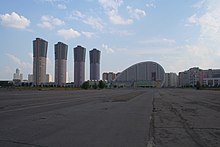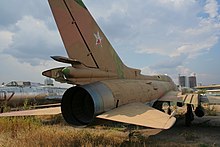Chodynka field
The Chodynka Field ( Russian Ходынское поле , Chodynskoje pole ) is a historical location northwest of Moscow city center and immediately south of the " Leningrad Prospect " road. The area, which is now partially built-up, has served as a military site throughout its history, but also as Moscow's first passenger airport .
history
The Chodynka field was mentioned in a document from Moscow's Grand Duke Dmitri Donskoy in 1389 under its name, which is known to this day and which is based on the Chodynka river that once ran here and is now largely underground . There the field was called Chodynka Meadow . At that time and until the 18th century, the field was mainly used for agriculture , until the middle of the 19th century it was outside the Moscow city limits. In July 1609 - in the middle of the so-called time of turmoil - the Chodynka field was the scene of the fighting between the troops of Tsar Vasily IV (Shuiski) and the impostor Pseudodimitri II.
After the field was no longer used as an agricultural area, military training areas , barracks and military camps were set up there. In addition, larger exhibitions and folk festivals were occasionally held there . One of the most famous such events on the Chodynka Field is the celebration of the Peace of Küçük Kaynarca , which was held in 1775 and ended the Russo-Turkish War of 1768–1774 . Around 60,000 people took part in this festival at the time.
The All-Russian Industrial and Crafts Exhibition in 1882 was also held on the Chodynka Field . In May 1896, the Chodynka field was the scene of a particularly large folk festival with several hundred thousand visitors on the occasion of the coronation of the last Russian tsar Nicholas II. This festival ended in a catastrophe, the so-called Chodynka tragedy : a mass panic that occurred while the gifts were being handed out , 1389 people were killed.

From the beginning of the 20th century, the field was increasingly used as a test site by local flight pioneers and test pilots (including Pyotr Nesterow , and later Valeri Tschkalow ). In 1910 the first Moscow airfield was founded on a large part of the field, which was designed as a passenger airport by 1922 and since then has handled both domestic and international flights (such as Moscow - Koenigsberg - Berlin ). The aircraft designer Alexander Yakovlev worked here. Until the construction of Bykowo airport in the Moscow area in 1933, the airport on the Chodynka field was the only one in Moscow. He gave the residential area to the north and along the Leningrad Prospect as well as the nearby metro station opened in 1938 the name Aeroport (literally "airport").
With the opening of several new commercial airports in the greater Moscow area - including Vnukowo airport in 1941 - the importance of the Chodynka airfield for passenger traffic declined. It was increasingly used as a feeder airfield: passengers from other airports could check in there and were initially transported to their respective aircraft by helicopter and later by bus. The passenger terminal (known as Aerowoksal , literally "Aerobahnhof") in the north of the Chodynka field served as a bus station until the 1990s.
In the post-war period, the use of the Chodynka field as a civil airport was given up. The existing runway was taken over by the Soviet military and has since served as a military airfield , which was named after the revolutionary Mikhail Frunze . Several well-known experimental design offices for aeronautical engineering have settled in the vicinity of the airfield (including Sukhoi , Ilyushin , Jakowlew , MiG ). In addition to military aircraft and helicopters, test flights of passenger aircraft started on the Chodynka field.
Todays use
In 2003 the Frunze military airfield was shut down, parts of the airfield area have meanwhile been built with new apartment blocks and other objects such as the multifunctional hall " Megasport-Arena ", which opened in 2006 . The headquarters of the military secret service GRU is located on the southern edge of the site .
Of the original facilities, only the former runway, which is used as a practice route for drivers and motorcyclists, remains today, and larger arable land around the runway is currently fallow. The construction of further residential areas on the former airfield is planned. In 1991 an aviation museum was opened, but it was also closed when the field was closed due to a lack of financial means. The military aircraft on display, including rare prototypes from the design offices formerly located on the square, are already standing along the former runway, insofar as they could not be taken over by other museums, and are currently in fact exposed to decay and vandalism.
In the run-up to the Victory Day military parades , which take place every year on May 9th on Red Square , the former airfield serves as a gathering place for the military equipment used. On the day of the parade and during rehearsals, the technology will be transported from the Khodynka field to the nearby Leningrad Prospect and from there via Tverskaya Street to the city center.
Individual evidence
- ↑ Farewell to Chodynka ( Memento of the original from June 25, 2009 in the Internet Archive ) Info: The archive link was inserted automatically and has not yet been checked. Please check the original and archive link according to the instructions and then remove this notice. , December 9, 2007
- ↑ Patrick Hoeveler: Aircraft Collection in Chodinka - Sad end. In: Classics of Aviation No. 2/2013, p. 39
- ↑ Военная техника приехала на Ходынское поле ; RIA Novosti , April 27, 2010
Web links
- History of the Chodynka Field (Russian)
- Brief description on moscow.gramota.ru (Russian)
Coordinates: 55 ° 47 ′ 19.3 " N , 37 ° 31 ′ 47.4" E

